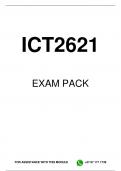Exam (elaborations)
ICT2621 EXAM PACK 2023
- Institution
- University Of South Africa (Unisa)
ICT2621 Latest exam pack questions and answers and summarized notes for exam preparation. Updated for October November 2023 exams . For assistance Whats-App.0.6.7..1.7.1..1.7.3.9 . All the best on your exams!!
[Show more]



